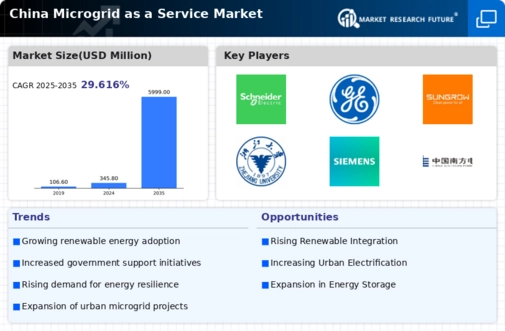Rising Energy Demand
The increasing energy demand in China is a pivotal driver for the microgrid as-a-service market. As urbanization accelerates and industrial activities expand, the need for reliable and efficient energy solutions becomes paramount. In 2025, China's energy consumption is projected to rise by approximately 3.5% annually, necessitating innovative approaches to energy management. Microgrids offer localized energy generation and distribution, which can alleviate pressure on the national grid. This localized approach not only enhances energy security but also supports the integration of renewable energy sources. The microgrid as-a-service market is thus positioned to capitalize on this growing demand, providing tailored solutions that meet the specific needs of various sectors, including residential, commercial, and industrial applications.
Decentralization of Energy Systems
The trend towards decentralization in energy systems is significantly influencing the microgrid as-a-service market. In China, there is a noticeable shift from centralized power generation to decentralized models, which allows for greater flexibility and resilience. This transition is driven by the need to enhance energy security and reduce transmission losses. By 2025, it is estimated that decentralized energy systems could account for over 30% of the total energy mix in urban areas. Microgrids facilitate this decentralization by enabling localized energy production and consumption, thereby reducing reliance on traditional grid infrastructure. The microgrid as-a-service market is likely to thrive as businesses and communities seek to implement these decentralized solutions, fostering energy independence and sustainability.
Investment in Infrastructure Development
Investment in infrastructure development is a critical driver for the microgrid as-a-service market in China. The government has committed substantial resources to modernize energy infrastructure, with plans to invest over $200 billion in renewable energy projects by 2025. This investment is expected to enhance the capacity and reliability of energy systems, creating a favorable environment for microgrid deployment. As new infrastructure is developed, the integration of microgrids becomes more feasible, allowing for improved energy access in remote and underserved areas. The microgrid as-a-service market is likely to benefit from this infrastructure push, as stakeholders seek to implement innovative energy solutions that align with national development goals.
Technological Innovations in Energy Management
Technological innovations in energy management systems are driving growth in the microgrid as-a-service market. Advances in smart grid technology, IoT, and data analytics are enabling more efficient energy distribution and consumption. In China, the adoption of these technologies is expected to increase by 25% by 2025, enhancing the operational efficiency of microgrids. These innovations allow for real-time monitoring and control of energy resources, optimizing performance and reducing costs. As businesses and communities become more aware of the benefits of smart energy management, the demand for microgrid solutions is likely to rise. The microgrid as-a-service market stands to gain from this trend, as it offers integrated solutions that leverage cutting-edge technology to improve energy efficiency and reliability.
Environmental Regulations and Sustainability Goals
China's stringent environmental regulations and sustainability goals are propelling the microgrid as-a-service market forward. The government has set ambitious targets to reduce carbon emissions by 30% by 2030, which necessitates a transition to cleaner energy sources. Microgrids, which can integrate renewable energy sources such as solar and wind, play a crucial role in achieving these targets. The microgrid as-a-service market is expected to benefit from this regulatory environment, as businesses and municipalities seek compliant energy solutions. Furthermore, the market could see an increase in investments, with projections indicating that the renewable energy sector in China may attract over $100 billion in funding by 2025. This influx of capital will likely enhance the development and deployment of microgrid technologies.

















Leave a Comment